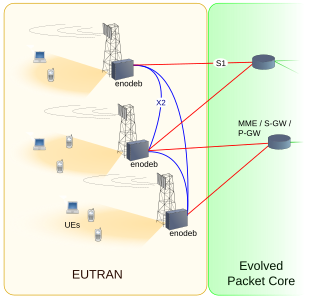Utra may refer to:
- 1447 Utra, asteroid
- E-UTRA, radio standard
- Utra (beetle), a genus of beetles in the subfamily Prioninae
- Utra Janubi, village in Pakistan
Utra may refer to:
The Universal Mobile Telecommunications System (UMTS) is a third generation mobile cellular system for networks based on the GSM standard. Developed and maintained by the 3GPP, UMTS is a component of the International Telecommunication Union IMT-2000 standard set and compares with the CDMA2000 standard set for networks based on the competing cdmaOne technology. UMTS uses wideband code-division multiple access (W-CDMA) radio access technology to offer greater spectral efficiency and bandwidth to mobile network operators.
Colon commonly refers to:
Moron or Morón may refer to:
Cat 7 or CAT7 may refer to:
HCR may refer to:

The Prioninae are a subfamily of Cerambycidae. They are typically large (25–70 mm) and usually brown or black. The males of a few genera sport large mandibles that are used in fights with other males, similar to stag beetles. These beetles are commonly nocturnal and are attracted to light. The majority of the Prioninae whose biology is known are borers whose larvae feed on rotting wood or roots.

E-UTRA is the air interface of 3rd Generation Partnership Project (3GPP) Long Term Evolution (LTE) upgrade path for mobile networks. It is an acronym for Evolved Universal Mobile Telecommunications System (UMTS) Terrestrial Radio Access, also referred to as the 3GPP work item on the Long Term Evolution (LTE) also known as the Evolved Universal Terrestrial Radio Access (E-UTRA) in early drafts of the 3GPP LTE specification. E-UTRAN is the initialism of Evolved UMTS Terrestrial Radio Access Network and is the combination of E-UTRA, user equipment (UE), and E-UTRAN Node B or Evolved Node B (eNodeB).
Al-Janubiyah or Al Janobiyah and Al Janub ('south'), or variants may refer to:
Single-carrier FDMA (SC-FDMA) is a frequency-division multiple access scheme. It is also called linearly precoded OFDMA (LP-OFDMA). Like other multiple access schemes, it deals with the assignment of multiple users to a shared communication resource. SC-FDMA can be interpreted as a linearly precoded OFDMA scheme, in the sense that it has an additional DFT processing step preceding the conventional OFDMA processing.
The UMTS frequency bands are radio frequencies used by third generation (3G) wireless Universal Mobile Telecommunications System networks. They were allocated by delegates to the World Administrative Radio Conference (WARC-92) held in Málaga-Torremolinos, Spain between 3 February 1992 and 3 March 1992. Resolution 212 (Rev.WRC-97), adopted at the World Radiocommunication Conference held in Geneva, Switzerland in 1997, endorsed the bands specifically for the International Mobile Telecommunications-2000 (IMT-2000) specification by referring to S5.388, which states "The bands 1,885-2,025 MHz and 2,110-2,200 MHz are intended for use, on a worldwide basis, by administrations wishing to implement International Mobile Telecommunications 2000 (IMT-2000). Such use does not preclude the use of these bands by other services to which they are allocated. The bands should be made available for IMT-2000 in accordance with Resolution 212 ." To accommodate the reality that these initially defined bands were already in use in various regions of the world, the initial allocation has been amended multiple times to include other radio frequency bands.
1447 Utra, provisional designation 1938 BB, is a stony asteroid, slow rotator and suspected tumbler from the central region of the asteroid belt, approximately 12 kilometers in diameter. It was discovered on 26 January 1938, by Finnish astronomer Yrjö Väisälä at Turku Observatory in Southwest Finland. The asteroid was named for the Finnish town of Utra.

LTE Advanced is a mobile communication standard and a major enhancement of the Long Term Evolution (LTE) standard. It was formally submitted as a candidate 4G to ITU-T in late 2009 as meeting the requirements of the IMT-Advanced standard, and was standardized by the 3rd Generation Partnership Project (3GPP) in March 2011 as 3GPP Release 10.
Tagalog may refer to:

Joost De Hurtere, also known by several transliterations was the first settler, and captain-major of the island of Faial in the Portuguese Azores. After 1482, the island of Pico was also incorporated into his captaincy. His son, Joss de Utra would later inherit the captaincy from him after his death.
E-UTRAN Node B, also known as Evolved Node B, is the element in E-UTRA of LTE that is the evolution of the element Node B in UTRA of UMTS. It is the hardware that is connected to the mobile phone network that communicates directly wirelessly with mobile handsets (UEs), like a base transceiver station (BTS) in GSM networks.
Long-Term Evolution (LTE) telecommunications networks use several frequency bands with associated bandwidths.
Enhanced Cell ID, E-CellID, or E-CID is a positioning feature introduced in rel9 E-UTRA. The UE reports to the network (ESMLC) the serving cell ID, the timing advance and the IDs, estimated timing and power of the detected neighbor cells. The enodeB may report extra information to the ESMLC like the angle of arrival. The ESMLC estimates the UE position based on this information and its knowledge of the cells positions.

Utra Gauri is a village in Lalganj block of Rae Bareli district, Uttar Pradesh, India. It is located 5km from Lalganj, the block and tehsil headquarters. As of 2011, it has a population of 3,630 people, in 643 households. It has three primary schools and no healthcare facilities.
The Asiet Malkia is one of the most commonly recited prayers in Mandaeism. In the prayer, the reciter wishes health and victory upon dozens of heavenly and ancestral figures. According to E. S. Drower, it is recited daily by priests and also before all baptisms (masbuta), ritual meals (lofani), and various rites.
In Mandaeism, Anush or Anush Uthra is an uthra from the World of Light. Anush is considered to be the Mandaean equivalent of Enos.